Science & Technology - 2017
April
Next-Generation NIF Optics Boost Energy and Limit Damage
Crash-Proof Virtual Flying Through NIF
In apparent defiance of the laws of physics, LLNL design engineer Paul Bloom leads flying tours through the National Ignition Facility from only three feet off the ground.
As creator of the NIF virtual reality (VR) program, Bloom routinely allows engineers, scientists, and technicians to soar through the facility by plugging his NIF tourists into special 3D Model Visualization portal headsets and his supercharged computer. Swooping them through the laser beampath at up to a hundred meters per second, he has turned NIF mechanical design on its head with his VR tools.
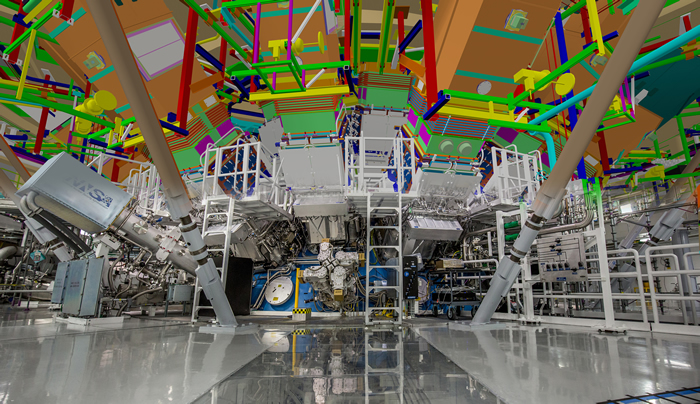 A virtual-reality rendering of the upper portion of the NIF Target Chamber exterior blended with a photo of the lower portion. By using realistic graphics designed with the aid of virtual reality programs by design engineer Paul Bloom, NIF researchers can efficiently navigate the facility and plan their experiments to maximize scientific results. Composite graphic credit: Brian Chavez
A virtual-reality rendering of the upper portion of the NIF Target Chamber exterior blended with a photo of the lower portion. By using realistic graphics designed with the aid of virtual reality programs by design engineer Paul Bloom, NIF researchers can efficiently navigate the facility and plan their experiments to maximize scientific results. Composite graphic credit: Brian Chavez Bloom has spent the last 20 years customizing his unique program by blending standard three-dimensional engineering CAD (computer-aided design) programs and maturing virtual reality software to meet the needs of his NIF & Photon Science colleagues.
“Not only is it supporting science, it’s about discovery and pushing the boundaries into new realms,” he says. “This kind of design engineering work is fun for me, which helps with the learning curve.”

Bloom flies engineers like Robin Hibbard virtually anywhere in the facility, from anterooms and exteriors to the heart of the Target Chamber, zooming close enough to touch without risk to humans or machinery. Hibbard, who finds Bloom’s VR invaluable for effective diagnostics placement planning, says, “You use something that’s not real to find out something that’s real.”
NIF Laser Systems Section Leader Mark Bowers taps Bloom extensively to perform engineering modeling for his group’s installations without having to shut NIF down for prolonged periods. “You can look at a drawing all day long,” Bowers says, “but you’re not going to see it really unless it’s in full dimension. This 3D immersive VR is even better because you can see through structures and inside and around in dense areas.”
On a recent visit to Bloom’s 3D Model studio across the road from NIF, Bowers straps on the black gleaming VR headset and dives into the NIF virtual structures like meeting up with old friends, as Bloom follows his progress from the computer across the room.
“Oh, there’s Dante (a key NIF diagnostic),” Bowers says. “There’s DIXI (the world’s fastest x-ray camera)…I’m riding up to the target now…Now we’ve got stuff going on…There’s the cryo (target positioner)…I believe that’s where Capt. Kirk died in Star Trek…” (the awe-inspiring NIF was the setting for the engine room in the 2013 blockbuster “Star Trek: Into Darkness”).
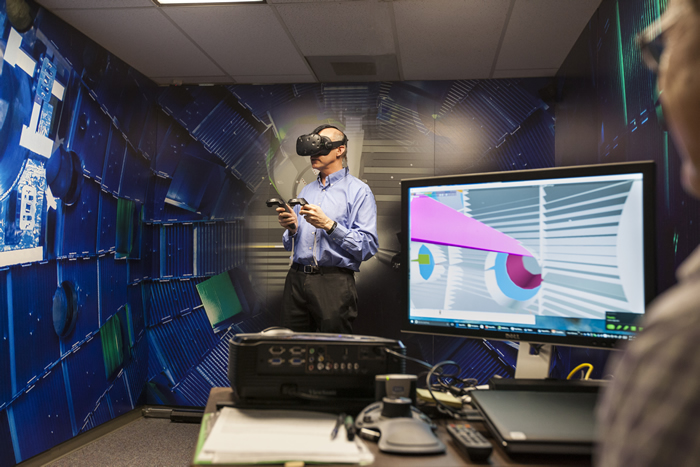 Laser Systems Section Leader Mark Bowers takes a virtual trip inside the NIF Target Chamber. Credit: Mark Meamber
Laser Systems Section Leader Mark Bowers takes a virtual trip inside the NIF Target Chamber. Credit: Mark Meamber After updating himself on what’s new in the virtual NIF, Bowers turns in his headset and calls out a long list of his team’s projects that benefited from VR pre-review, including the time he needed the measurement for an area in NIF under a vacuum seal and open only a few times a year. Another advantage of Bloom’s VR tours is that a person can “get inside” to be more prepared when the area opens, saving time, costs, and stumbles, says Bowers.
For example, NIF technicians get an opportunity to enter the Target Chamber only once a year, and only for a day or two. In order to make the most efficient use of this time, they “practice” critical operations using the VR system to tune up their procedures and equipment. This saves both time and money by keeping the Target Chamber entry activities on schedule.
Bloom has used many different software and CAD programs over the years and currently utilizes Virtalis software from a U.K.-based company that combines computer projectors and headsets resembling night-vision goggles. It ushers viewers into a private VR universe where they seemingly feel like they can walk through walls. To help simulate some of that NIF ambiance, NIF’s Document Services team papered the Model Visualization Studio’s walls with colorful wall-to-ceiling photographs of the Target Chamber.
Making Solid Structures Transparent
Recently Bloom installed diagnostic hardware in the complex and crowded space, because unlike standard 3D engineering software, his programs can see through solid structures. He’s helped determine how to install precision equipment and advised the transport and handling team on a verified transport path requiring minimal moving of existing equipment, again saving time and costs.
In the physical world, the technology of virtual reality can come as a jolt because objects sometimes seem to disobey the laws of physics. One of the issues involving flying at high speeds is the reaction that people can have to the experience of immersion. Bloom acknowledges what’s sometimes called sensory conflict theory, also known as motion sickness.
Some scientists and technical staff using the VR program prefer the standard non-immersive review, with Bloom flying them through the 3D model and the moving model image projected on a large screen. This makes it easy to interact with a group, capture screenshots, and take measurements. He also uses the VR program for training technicians, engineers, and scientists, along with real-time problem-solving capability.
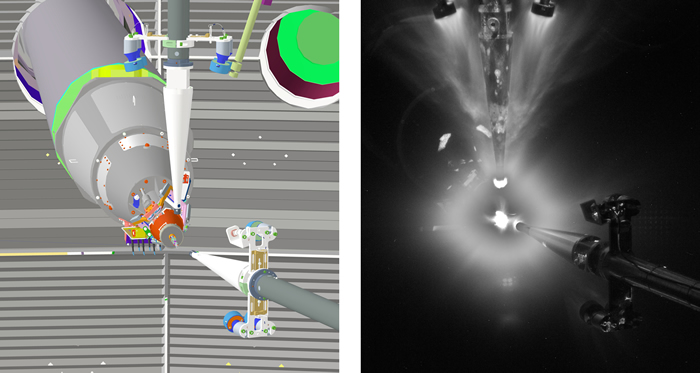 At right is a photograph of the NIF Target Chamber interior taken at shot time. On the left is Bloom’s 3D virtual model to match it, with the same angle and field of view, so scientists could see clearly the positioners and diagnostics present during the shot. This is an example of how virtual reality graphics models help differentiate the many intricate components. Photo credit: Don Jedlovec
At right is a photograph of the NIF Target Chamber interior taken at shot time. On the left is Bloom’s 3D virtual model to match it, with the same angle and field of view, so scientists could see clearly the positioners and diagnostics present during the shot. This is an example of how virtual reality graphics models help differentiate the many intricate components. Photo credit: Don Jedlovec Steve Mills, the NIF design integration supervisor, is a big fan of Bloom’s VR program because of the way it simulates areas otherwise difficult to reach. “People have been satisfied in the past with just using a monitor and the CAD programs,” Mills says. “Having Paul in that role has been fantastic, because he’s always looking out on the cutting edge of the technology and bringing it to us.”
Hibbard, the project engineer in NIF target diagnostics, finds that what is useful about Bloom’s VR program is putting himself in the Target Bay, virtually, and thinking about a new diagnostic. “You can fly around the building and see available space if you’re building something near the Target Chamber,” he says. “It’s a good tool to see how you’re going to solve a problem.”
For example, when Hibbard was working on a new polar nuclear imaging system, he looked at options for locating a new nuclear imaging line-of-sight diagnostic and decided that he had to adjust the angle through the port to get a line of sight without difficult structural steel interference. Nuclear imaging looks at the shape of the compression of target capsules based on the generation of neutrons late in time, in the last half of the implosion. “We looked for a line of sight for a detector that would potentially make use of existing target building wall penetrations while avoiding surrounding hardware, yet still achieve the desired physics outcome,” he says.
Bloom has worked successfully with many other scientists and engineers, including Jonathan Fry, Sky Marshall, Matt Fischer, and Justin Galbraith, exploring the versatility of the virtual reality program and expanding its capabilities. Recent projects have involved providing laser light ray-trace and shadow-casting within the NIF model, animating systems to simulate operating hardware motion, and creating model animations for diagnostic motions and clearances for the transport and handling team.
On a recent Tuesday morning, LLNL physicist Rich Zacharias came in to talk about VR’s potential for target design. The project he proposed was to bring detailed target models and laser-beam aiming models together in the virtual world, allowing the reviewer in the headset to control the scaling of the models or the magnification of the view in order to understand the interaction of target components and laser beams.
“I’m really excited,” Bloom said, “because it opens a whole new realm for me.”
Next-Generation NIF Optics Boost Energy and Limit Damage
A new anti-reflective coating and a novel chemical process for laser optics developed by LLNL researchers represent an important breakthrough in the Laboratory’s effort to boost the energy of NIF’s 192 giant lasers and cut the cost of repairing or replacing damaged optics vital to its operation.
The coating was developed to overcome energy-robbing reflections from the rear surface of the facility’s grating debris shields, or GDSs. The GDS is the penultimate optic before NIF’s laser beams enter the Target Chamber, protecting other optics from the Target Chamber environment and helping diagnose the energy of NIF’s laser beams.
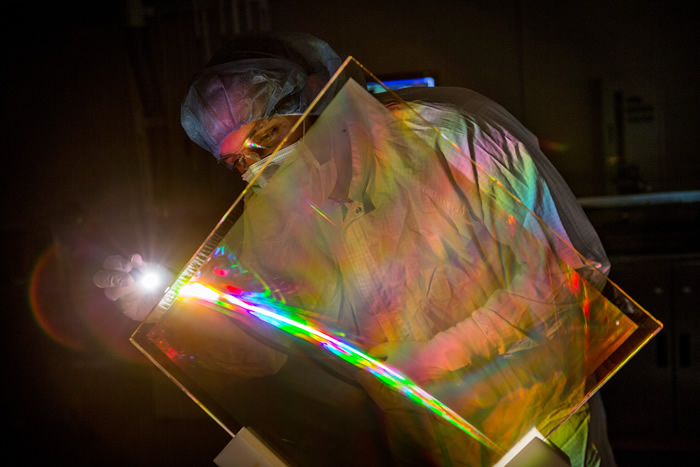 Marcus Monticelli inspects the anti-reflective coating on a new NIF grating debris shield. The coating restores lost NIF energy and eliminates a source of optics damage. Credit: Jason Laurea
Marcus Monticelli inspects the anti-reflective coating on a new NIF grating debris shield. The coating restores lost NIF energy and eliminates a source of optics damage. Credit: Jason Laurea A patented chemical process called the Advanced Mitigation Process (AMP) further protects the optics by making their surfaces more damage-resistant by removing impurities and absorbing microfractures. When exposed to laser light, these imperfections create tiny damage craters on the surface which grow with repeated laser shots and limit the lifespan of the optic. Both the AMP process and the coating are required to realize these reductions to the damage rate and the possibility of higher energy on NIF.
The technologies are a result of sustained research and development over the past decade, much of it supported by LLNL’s Laboratory Directed Research and Development (LDRD) Program. This effort involved forming a fundamental understanding of the chemistry and physics involved—including isolating and identifying nanoscale absorbing precursors leading to laser damage, understanding the complex laser-matter-interaction physics, and developing novel chemical processes to mitigate them.
“Maximizing the amount of energy and shots reaching NIF targets is a critical factor in the facility’s efforts to serve the needs of its users and Laboratory missions,” said Tayyab Suratwala, program director for Optics and Materials Science and Technology (OMST). “By minimizing the damage rate to NIF’s optics, we can save considerable time and expense involved in recycling or replacing optics that become unusable, and thereby increase the number of shots available to experimenters,” he said.
NIF is the world’s largest and highest-energy laser system, capable of creating the extreme temperatures and pressures necessary for science-based stockpile stewardship and a deeper understanding of the universe. In NIF laser shots a complex series of optics, including amplifiers, mirrors, and wavelength converters, strengthens and guides laser light into the Target Chamber. There it is focused on miniature targets for inertial confinement fusion and high energy density physics experiments.
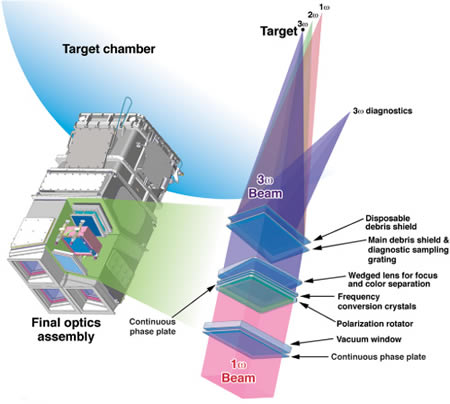
The GDS diffracts a small amount of laser light and sends it to a device used to measure its energy to help researchers balance the laser energy in NIF’s beams as they enter the Target Chamber. Problematic reflections from this optic ultimately became responsible for much of the damage it experiences, according to Marcus Monticelli, LLNL process engineering lead.
A grating is a diffractive optic that splits light into different wavelengths that travel in certain directions, roughly analogous to the rainbow pattern seen on the back of a compact disc. “These gratings have to be very stable,” Monticelli said. “The way to keep it stable, historically, was to leave it uncoated, because the index of refraction of the coating can change with time. That will affect diffraction efficiency significantly, and that would cause power balancing issues on NIF.”
But leaving a fused silica optic like the GDS uncoated results in a penalty in energy: at the 352-nanometer, or ultraviolet, final wavelength of NIF’s lasers, 3.7 percent of the laser energy reflects back up the beamline from the optic’s exit surface and must be captured by a beam dump so it won’t damage other optics.
“When you’re talking about 1.8 megajoules on NIF in three nanoseconds, that’s a very big chunk of power,” Monticelli said, noting that researchers have sardonically joked that “the world’s largest laser is NIF, and the world’s second largest laser is the reflection off NIF optics.”
Some of this reflected light bounced around in the integrated optics module (IOM) containing the final optics, creating a highly focused beam of light—a focusing “ghost”—that was intense enough to damage the IOM’s stray-light-absorbing glass just above the exit surface of the GDS. “Every time we shot the laser,” said Jeff Bude, science and technology lead, “it was damaging the IOM and spewing debris all over the GDS.”
Recycling Damaged Optics
The debris particles created thousands of potential damage sites on the GDS, many of which, when exposed to NIF’s high-energy laser beams, eventually grew large enough to render the optic useless. “The debris-caused damage was limiting the performance of the inherently damage-resistant AMP-treated optic,” Bude said. “Understanding and solving this problem was a result of sustained research and development on the impact of various types of debris on laser damage and from novel experiments on NIF and in offline laser test laboratories.”
Due to this and other causes, as many as 30 to 40 optics a week had to be removed from service so that damage sites could be locally repaired through a process known as the “NIF Optics Recycle Loop.” The loop is designed to assure that NIF economically operates at maximum energy by limiting the likelihood of damage and acting quickly to mitigate further damage when it does occur.
To solve the reflected-light problems, an LLNL-developed colloidal silica particle coating, made by a sol-gel chemical process, was used on the grating surface of the GDS. The particles were treated with a chemical that modifies the surface, making them more immune to changes in humidity and other environmental factors. Tests showed it was ideal for use as a GDS coating.
To accommodate the coatings, the team needed to modify the process for lithographically imprinting the holographic gratings on the exit surface of the GDS optics.
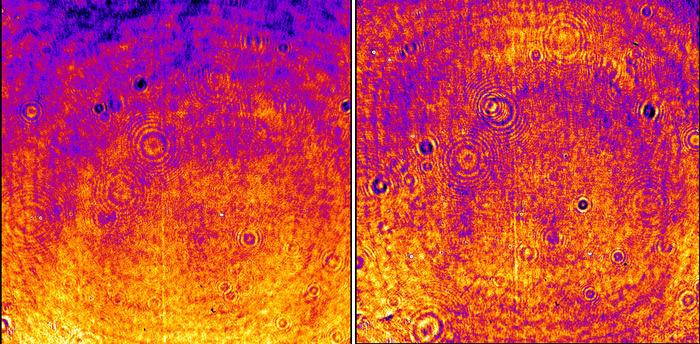
Testing the coated and AMPed GDS began about two years ago. As of March, NIF is about three quarters of the way through replacing uncoated GDSs with the new model as the older versions outlive their usefulness. The team predicts that the recycle rate for damaged optics will be cut in half—from 30 to 40 a week to 10 to 20 a week—when all the anti-reflective GDSs are in place. At the current shot rate, the number of new GDSs that will need to be purchased will drop from about 130 a year to about 40, Suratwala said—a significant cost savings.
For more information, see “Particle damage sources for fused silica optics and their mitigation on high energy laser systems,” Optics Express, May 15, 2017.
NIF experiments support the National Nuclear Security Administration’s Stockpile Stewardship Program to ensure the safety, security and reliability of the nation’s nuclear deterrent, while also providing scientists from around the world with unique conditions of heat and pressure for fundamental science studies.



